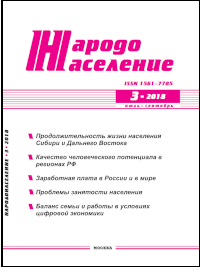Макрорегионы России: характеристика человеческого потенциала
Выражение признательности
НИР по государственному заданию на 2018 год по теме «Социальныеэкономические и экологические факторы формирования и развития человеческого потенциала в российских регионах» (№ 0165-2018-0011)
Для цитирования
Локосов В. В., Рюмина Е. В., Ульянов В. В. Макрорегионы России: характеристика человеческого потенциала // Народонаселение. 2018. Том 21. № 3. С. 37-51.
Аннотация
Проведенный кластерный анализ качества человеческого потенциала российских регионов выявил существенное влияние на его характеристики фактора географического местоположения. На этой основе в статье показана целесообразность разделения всех субъектов федерации в рассматриваемом аспекте на три макрорегиона: регионы европейской части страны, южные и северокавказские регионы, регионы Урала, Сибири и Дальнего Востока. По каждому макрорегиону отдельно проведен кластерный анализ на информации за 2016 год о качестве населения в разрезе семи социальных показателей, отражающих здоровье, образовательный и культурный уровень, преступность, алкоголизм и наркоманию, а также экологическое поведение населения. В результате построена классификация субъектов федерации для каждого макрорегиона и определены средние характеристики качества населения в полученных группах (центры кластеров). Проведен детальный содержательный анализ результатов кластеризации отдельно по каждому макрорегиону. Исследованы различия средних показателей качества населения по кластерам одного макрорегиона, а также их отклонения от среднероссийских показателей. В отдельных случаях рассмотрена развернутая характеристика кластера — информация по каждому входящему в него региону. Этот этап, в частности, проведен с целью более подробного изучения человеческого потенциала двух субъектов федерации — г. Севастополь и Республики Крым. В каждом макрорегионе выявлены кластеры с максимальными и минимальными значениями характеристик качества населения. На основе полученных результатов сделаны выводы о первостепенных направлениях социальной политики в регионах каждой группы.
Ключевые слова:
человеческий потенциал, качество населения, субъект федерации, федеральный округ, макрорегион, социальные показатели, кластер, кластерный анализ
Литература
Римашевская Н.М. Качественный потенциал населения России: взгляд в XXI век // Проблемы прогнозирования. — 2001. — № 3. — С. 34-48.
Римашевская Н.М., Мигранова Л.А., Токсанбаева М.С. Человеческий и трудовой потенциал российских регионов // Народонаселение. — 2014. — № 3. — С. 106-119.
Мигранова Л.А. Пространственная дифференциация качества жизни населения Рос-сии // Научное обозрение. Серия 1. Экономика и право. — 2017. — № 6. — С. 37-54.
Локосов В.В., Рюмина Е.В., Ульянов В.В. Качество населения: связь с экономическим развитием региона // Народонаселение. — 2016. — № 4. — С. 68-76.
Рюмина Е.В. Экологические характеристики человеческого потенциала // Сборник трудов XIII Международной научно-практической конференции Российского обще-ства экологической экономики RSEE-2015 /РОЭЭ-2015 «Теория и практика экономи-ческого регулирования природопользования и охраны окружающей среды». — М.: 2015. — С. 63-78.
Регионы России. Социально-экономические показатели. 2017. Статистический сбор-ник. М.: Росстат. 2017. 1402 с.
Brian S. Everitt. Cluster analysis. Fifth Edition / Brian S. Everitt. Sabine Landau, Morven Leese, Daniel Stahl. — U.K: John Wiley & Sons. — 2011.
Lior Rokach. A Survey of Clustering Algorithms. In: Data Mining and Knowledge Discovery Handbook. Second Edition / Editors: Oded Maimon and Lior Rokach. — New York: Springer, 2010 — P. 269-298.
Dan A. Simovici. Mathematical Tools for Data Mining. Second edition [Text] / Dan A. Si-movici, Chabane Djeraba. — London: Springer-Verlag, 2014.
Римашевская Н.М., Мигранова Л.А., Токсанбаева М.С. Человеческий и трудовой потенциал российских регионов // Народонаселение. — 2014. — № 3. — С. 106-119.
Мигранова Л.А. Пространственная дифференциация качества жизни населения Рос-сии // Научное обозрение. Серия 1. Экономика и право. — 2017. — № 6. — С. 37-54.
Локосов В.В., Рюмина Е.В., Ульянов В.В. Качество населения: связь с экономическим развитием региона // Народонаселение. — 2016. — № 4. — С. 68-76.
Рюмина Е.В. Экологические характеристики человеческого потенциала // Сборник трудов XIII Международной научно-практической конференции Российского обще-ства экологической экономики RSEE-2015 /РОЭЭ-2015 «Теория и практика экономи-ческого регулирования природопользования и охраны окружающей среды». — М.: 2015. — С. 63-78.
Регионы России. Социально-экономические показатели. 2017. Статистический сбор-ник. М.: Росстат. 2017. 1402 с.
Brian S. Everitt. Cluster analysis. Fifth Edition / Brian S. Everitt. Sabine Landau, Morven Leese, Daniel Stahl. — U.K: John Wiley & Sons. — 2011.
Lior Rokach. A Survey of Clustering Algorithms. In: Data Mining and Knowledge Discovery Handbook. Second Edition / Editors: Oded Maimon and Lior Rokach. — New York: Springer, 2010 — P. 269-298.
Dan A. Simovici. Mathematical Tools for Data Mining. Second edition [Text] / Dan A. Si-movici, Chabane Djeraba. — London: Springer-Verlag, 2014.
Форматы цитирования
Другие форматы цитирования:
APA
Локосов, В. В., Рюмина, Е. В., & Ульянов, В. В. (2018). Макрорегионы России: характеристика человеческого потенциала. Народонаселение, 21(3), 37-51. извлечено от https://www.jour.fnisc.ru/index.php/population/article/view/6430
Раздел
КАЧЕСТВО НАСЕЛЕНИЯ В РЕГИОНАХ РФ








